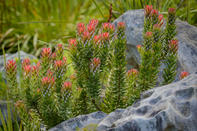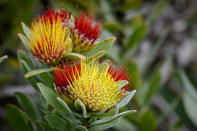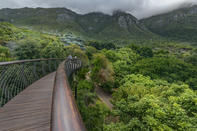The two vegetation types found in the Kirstenbosch National Botanical Gardens are fynbos and forest.

The three types of fynbos each have their own soils derived from rock types, which are as follows: Peninsula Granite Fynbos on the lower slopes and valleys, Peninsula Sandstone Fynbos on the middle and upper slopes and a bit of Cape Winelands Shale Fynbos on the north eastern edge of the Kirstenbosch estate.
Peninsula Fynbos

Peninsula Fynbos is most well-known by its tall proteas, ericas, restios and other shrubs. The Protea Family is represented by silver tree, wagon tree, sugarbush, green protea, tufted pincushion and green pincushion, all of which grow on the lower slopes of Table Mountain. The beautiful king protea also grows wild in Kirstenbosch and can be seen at the top of the Nursery Ravine (which requires a bit of a climb). They flower mainly during winter, spring and early-summer.
Ericas are a heath-like plant with small leaves, and its variants can be seen in the gardens. These include hairy-flower heath, berry heath, brown tongue heath and pink-rose heath. Other heath-like plants found in Kirstenbosch includes prickly roella, Cape gorse, china flower and mountain buchu. Restios are known as Cape reeds and the variants you’ll see are thatching reed, rustling restio and square-stem restio.
The other fynbos species you’ll find at Kirstenbosch is Cape agapanthus, clover-like suring, watsonia species, hooded pelargonium, blue sage, Cape snowdrop, sundews and red crassula. If you follow the Silvertree trail or travel up Skeleton Gorge you’ll most likely spots red disa flowering.
Afromontane Forest

The name Afromontane means ‘mountain forest of Africa’ and covers around 0.5% of Africa. It occurs in isolated spaces, such as a series of forest islands, in the Western Cape mountains, and the east of Drakensberg all the way to Limpopo. Such forests are found in well-watered kloofs and south-facing slopes as it needs rich soil and high rainfall. Afromontane forests are dominated by evergreen trees and are found in the kloofs and slopes below the highest peaks of the mountain.
During the late 1600s and early 1700s, thousands of trees were cut down to be used for timber and later alien trees were planted for the Cape’s timber needs, leading to a further reduction of the forest. The forest was proclaimed a protected area in 1913, and in the 1960s alien species were uprooted so that the forests could be left to recover and regenerate naturally. The types of tree species found in Kirstenbosch include Cape holly, real yellowwood, stinkwood, hard pear, rooiels and Cape beech.
 If you have only a day or two in Cape Town on your South African holiday, this self-drive route around the Cape to Cape Point covers the gre...
If you have only a day or two in Cape Town on your South African holiday, this self-drive route around the Cape to Cape Point covers the gre...